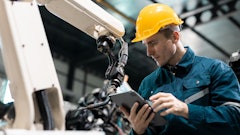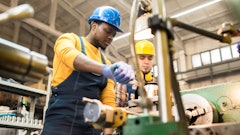
The manufacturing industry is facing three simultaneous challenges: an aging workforce, a growing talent shortage, and escalating pressure to digitize due to economical and geo-political pressures. By 2030, 2.1 million manufacturing roles are expected to go unfilled, threatening everything from productivity to national competitiveness. In response, many industrial leaders are turning to advanced technologies such as AI to bridge the gap. According to the 2025 State of Production Health (SOPH) report, 99% of executives believe that adopting advanced technologies will positively impact upskilling efforts. Nearly 90% say these technologies will help create – not eliminate – jobs. But technology alone fails to solve all problems. If we, as an industry, want to truly empower their workforce, we must rethink how technology is designed, delivered, and adopted. The future of upskilling depends equally on the tools developed and how well these tools align with user needs.
Usability is the missing link between talent and technology
Think about the last time you handed a 4-year-old an iPad. Without any instruction, they know how to tap, swipe, and navigate a complex digital environment. Or consider what happened when ChatGPT entered the mainstream: People didn’t need tutorials or training manuals, they just started typing instructions in natural language. The technology faded into the background. The interface became the conversation.
Expect the same ease of use from the technologies reshaping our factories. Unfortunately, we’ve come to accept complexity as inevitable and that’s costing us. For years, the industry has pointed to a “skills gap” as the primary barrier to digital transformation. The World Economic Forum suggests a more nuanced truth, that many digital tools are simply too complex for widespread adoption. Interfaces are unintuitive. Workflows are rigid. Training resources are outdated. As a result, frontline workers who are responsible for daily operations are often left behind.
This has serious business consequences. Poor usability increases onboarding time, drives errors, and reduces trust in the tools that are meant to support production. In fact, while SOPH data shows that AI adoption has scaled significantly across manufacturing sites, upskilling remains the lowest-priority objective among organizations deploying AI. That’s a missed opportunity. When systems are designed without frontline input, adoption stalls. Morale suffers. And the very tools that promised to alleviate workforce strain end up reinforcing it. Usability isn’t a “nice to have,” it’s a workforce multiplier.
Human-centered tech accelerates learning and confidence
In today’s operating environment, manufacturers don’t have the luxury of time. Facilities need to get new hires up to speed quickly, which is sometimes in a matter of weeks, not months. Human-centered technology makes that possible. When systems are intuitive, accessible, and purpose-built for non-specialist users, they accelerate learning and close performance gaps.
SOPH findings highlight this shift in maturity: the number of companies rolling out AI across more than 50% of their sites more than tripled year-over-year. But deployment doesn’t always mean impact. If workers don’t trust or understand the system, adoption lags. On the other hand, when digital tools are easy to navigate and provide clear, contextual insights, newer employees can operate with the confidence and efficiency of their more experienced peers.
The observed patterns appear to repeat across different age groups. A recent survey of 1,000 U.S. adults 18-plus reveals Millennial and Gen Z respondents view AI's manufacturing impact in a more positive light than older generations. These demographics most often describe factory work as both stressful and challenging. Human-centered tools resolve the workplace conflict by providing self-directed work capabilities and better clarity and transforming work into more satisfying experiences.
Upskilling must be embedded in operations, not sporadic
Legacy training approaches like manuals, classroom sessions, and one-off modules aren’t keeping pace with the complexity and urgency of modern manufacturing. The modern workforce requires immediate context-based assistance which integrates naturally into their regular tasks. The most successful tools today provide built-in learning functions and automated suggestions together with interactive tutorials that adapt to user development.
The SOPH report confirms that challenges like “digital change management” and “disconnected systems” are top barriers to reaching production goals. These aren’t abstract issues, they’re the direct result of technology that isn’t designed to support continuous learning. To upskill effectively, manufacturers need to meet workers where they are, using technology that’s flexible, familiar, and functional from Day 1.
This shift requires more than just new tools, it requires a new mindset. Upskilling can no longer be treated as a box to check. It must be part of how work gets done. The manufacturers making the most progress today are the ones who recognize that learning doesn’t stop at onboarding. It happens in the flow of work, through systems that teach, guide, and adapt.
A smarter way forward
As the manufacturing workforce evolves, so too must the tools designed to support it. The pressure to digitize is real but speed without usability is a recipe for stalled transformation. If manufacturers want to attract, retain, and elevate talent in the age of AI, they must also be selective about the partners they trust. Vendor reliability, which can be measured by indicators like alert response rate, false alarms, and the number of missed events, can make or break technology adoption. It’s time to stop designing tools for idealized users and start building them for the manufacturing workforce of today.
Human-centered tech is more adoptable and effective. It enables learning on the job, shrinks the experience gap, and turns digital transformation from a technical challenge into a people-first opportunity. It creates a stronger link between operational goals and human outcomes, helping manufacturers improve not just productivity metrics, but engagement, retention, and job satisfaction.
Ultimately, the success of any technology depends on the people behind it. And in an industry where time, talent, and trust are in short supply, we can’t afford to overlook the power of usable design. The future of upskilling and the future of manufacturing will belong to those who build for people first.



















